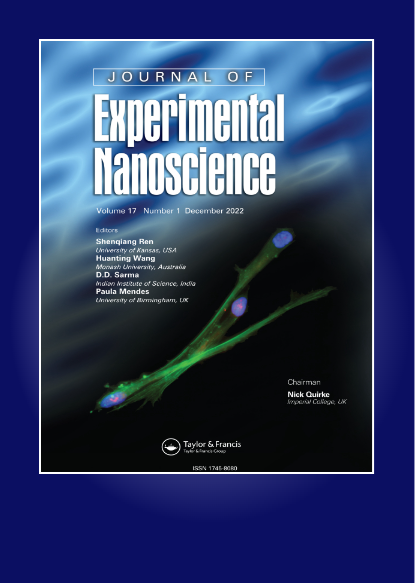用绿色化学方法合成锌纳米颗粒治疗肺高分化支气管源性腺癌
IF 2.6
4区 材料科学
Q2 CHEMISTRY, MULTIDISCIPLINARY
引用次数: 1
摘要
摘要本研究以香柏根茎水提物为原料,绿色合成氧化锌纳米颗粒。化学方法:EDX, FE-SEM, XRD, UV-Vis。,用FT-IR分析表征ZnONPs@C。采用分析技术对其进行了表征。FE-SEM图像显示纳米颗粒为球形,尺寸范围为38.05 ~ 75.41 nm, XRD结果表明ZnONPs@ C. rotundus晶粒尺寸为33.09 nm。采用MTT法对常见肺高分化支气管源性腺癌细胞株HLC-1进行细胞毒性及抗肺高分化支气管源性腺癌作用的研究。为了确定合成的纳米颗粒的抗氧化性能,采用DPPH试验,以丁基羟基甲苯为阳性对照。合成的纳米颗粒具有极低的细胞活力和高的抗肺高分化支气管源性腺癌活性,对HLC-1细胞系具有剂量依赖性,对正常细胞系(HUVEC)没有细胞毒性。在所合成的纳米颗粒浓度为41µg/mL时,抑制了一半的DPPH分子。合成的纳米颗粒对常见的人肺高分化支气管腺癌细胞系具有显著的抗人肺高分化支气管腺癌潜能,可能与其抗氧化活性有关。本文章由计算机程序翻译,如有差异,请以英文原文为准。
Green chemistry approach to the synthesis of zinc nanoparticles using Cyperus rotundus rhizome extract for the treatment of lung well-differentiated bronchogenic adenocarcinoma
Abstract In the present study, zinc oxide nanoparticles were green-synthesized using the aqueous extract of the rhizomes of Cyperus rotundus. The chemical methods EDX, FE-SEM, XRD, UV-Vis., and FT-IR analysis were used to characterize ZnONPs@C. rotundus were characterized by analytical techniques including. The FE-SEM image revealed a spherical shape for the nanoparticles in a size range of 38.05 to 75.41 nm and 33.09 nm was calculated for ZnONPs@ C. rotundus crystal size using the XRD results. MTT assay was used on common lung well-differentiated bronchogenic adenocarcinoma cell line i.e. HLC-1 to survey the cytotoxicity and anti-lung well-differentiated bronchogenic adenocarcinoma effects of the synthesized nanoparticles. To determine the antioxidant properties of the synthesized nanoparticles, the DPPH test was used in the presence of butylated hydroxytoluene as the positive control. The synthesized nanoparticles had very low cell viability and high anti-lung well-differentiated bronchogenic adenocarcinoma activities dose-dependently against the HLC-1 cell line without any cytotoxicity on the normal cell line (HUVEC). The synthesized nanoparticles inhibited half of the DPPH molecules at the concentration of 41 µg/mL. Maybe significant anti-human lung well-differentiated bronchogenic adenocarcinoma potentials of the synthesized nanoparticles against common human lung well-differentiated bronchogenic adenocarcinoma cell lines are linked to their antioxidant activities.
求助全文
通过发布文献求助,成功后即可免费获取论文全文。
去求助
来源期刊

Journal of Experimental Nanoscience
工程技术-材料科学:综合
CiteScore
4.10
自引率
25.00%
发文量
39
审稿时长
6.5 months
期刊介绍:
Journal of Experimental Nanoscience, an international and multidisciplinary journal, provides a showcase for advances in the experimental sciences underlying nanotechnology and nanomaterials.
The journal exists to bring together the most significant papers making original contributions to nanoscience in a range of fields including biology and biochemistry, physics, chemistry, chemical, electrical and mechanical engineering, materials, pharmaceuticals and medicine. The aim is to provide a forum in which cross fertilization between application areas, methodologies, disciplines, as well as academic and industrial researchers can take place and new developments can be encouraged.
 求助内容:
求助内容: 应助结果提醒方式:
应助结果提醒方式:


